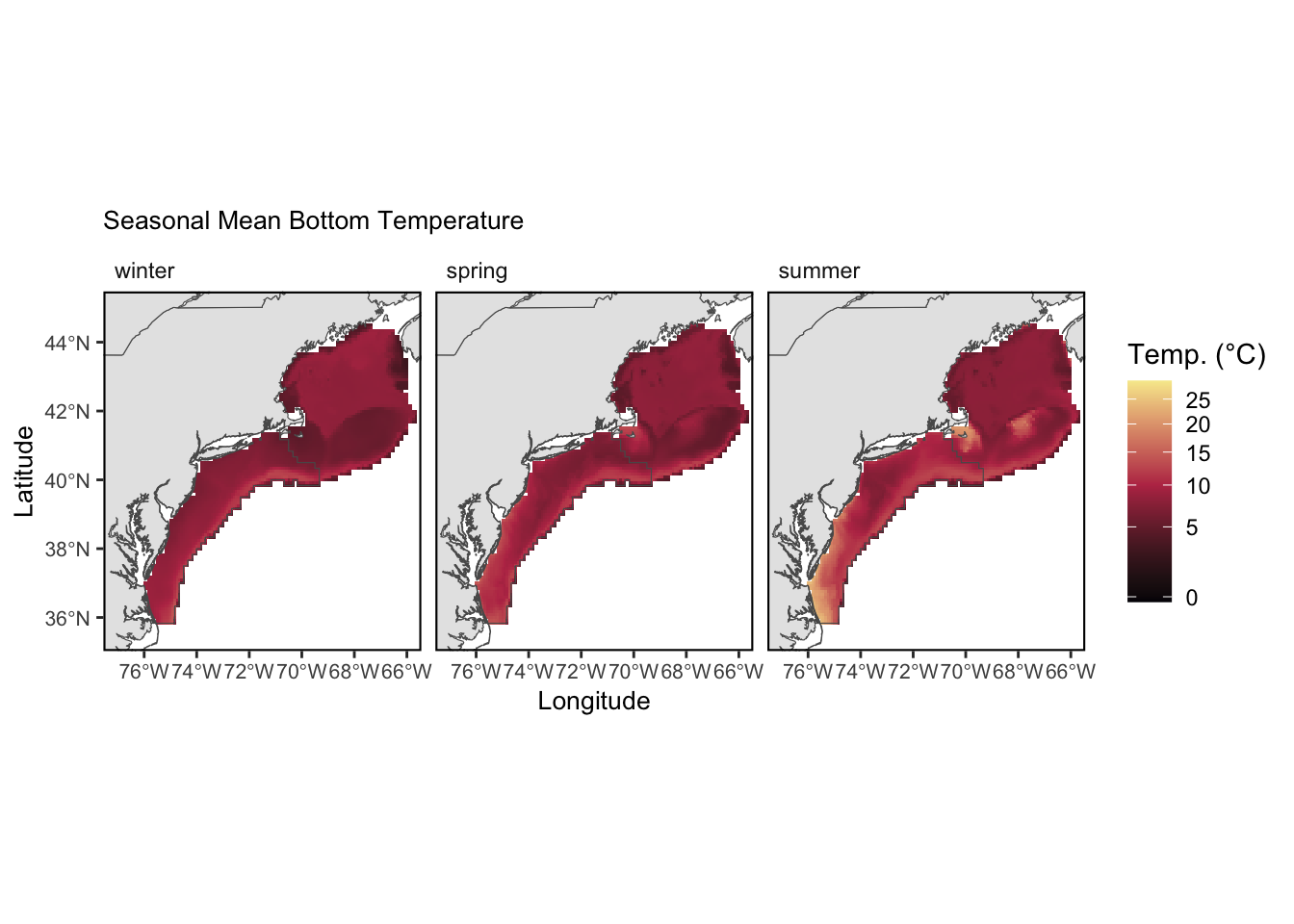SMART Indicator Report: Bottom temperature - Seasonal Gridded
2 Indicator name
Bottom temperature - Seasonal Gridded
Includes variable(s): fall, spring, summer, winter
3 Indicator brief description
Seasonal mean bottom temperatures on the Northeast Continental Shelf between 1959 and 2024 in a 1/12° grid.
5 Indicator documentation
5.1 Are indicators available for others to use (data downloadable)?
## Yes5.1.1 Where can indicators be found?
## Data: https://noaa-edab.github.io/ecodata/index.html
## Description: https://noaa-edab.github.io/catalog/bottom_temp_model_gridded.html
## Technical documentation: https://noaa-edab.github.io/tech-doc/bottom_temp_model_gridded.html5.1.2 How often are they updated? Are future updates likely?
[need sequential look at datasets for update frequency. Future requires judgement]
5.2 Gather indicator statistics
5.2.2 Length of time series, start and end date, periodicity
General overview: Winter (Jan-Mar), Spring (April-June), Summer (July-Sept), Fall (Oct - Dec) from 1959-2024
Indicator specifics:
Indicator | EPU | StartYear | EndYear | NumYears | MissingYears |
|---|---|---|---|---|---|
fall | no EPU field | 1959 | 2023 | 65 | 0 |
spring | no EPU field | 1959 | 2024 | 66 | 0 |
summer | no EPU field | 1959 | 2024 | 66 | 0 |
winter | no EPU field | 1959 | 2024 | 66 | 0 |
5.2.3 Spatial location, scale and extent
General overview: Whole shelf
Indicator specifics:
Indicator | EPU |
|---|---|
fall | no EPU field |
spring | no EPU field |
summer | no EPU field |
winter | no EPU field |
5.3 Are methods clearly documented to obtain source data and calculate indicators?
## Yes5.3.1 Can the indicator be calculated from current documentation?
[Build link to Tech-doc, look for current and previous methods]
5.4 Are indicator underlying source data linked or easy to find?
[Build link to Tech-doc, look for source, may require judgements]
5.4.1 Where are source data stored?
[Build link to Tech-doc, look for source, may require judgement]
6 Indicator analysis/testing or history of use
6.1 What decision or advice processes are the indicators currently used in?
The bottom temperature product is in a horizontal 1/12 degree grid between 1959 and 2024 and is made of daily bottom temperature estimates from: Bias-corrected ROMS-NWA between 1959 and 1992 which was regridded in the same 1/12degree grid as GLORYS using bilinear interpolation; Years 1993 through fall 2024 are from CMEMS GLORYS12V1 global reanalysis bottom temperature.
6.2 What implications of the indicators are currently listed?
Bottom temperature is a key environmental parameter in defining the habitat and metabolic conditions of demersal and benthic species. Interannual and seasonal changes in bottom temperature can provide significant indicators of species productivity, spatial distributions, or mortality. Long-term trends in bottom temperature are indicators of regional implications of global climate change and may be used in evaluating climate risk for fisheries management.
6.3 Do target, limit, or threshold values already exist for the indicator?
[Fill by hand; if not in key results or implications, likely does not exist]
6.4 Have the indicators been tested to ensure they respond proportionally to a change in the underlying process?
[Fill by hand; if not in introduction, key results, or implications, likely not tested]

7 Comments
[Fill below by hand once above data complete]
7.1 Additional potential links to management in addition to uses listed above
7.2 What additional work would be needed for the Council to use the indicator?
7.3 What issues are caused if there is a gap or delay in data underlying the indicator